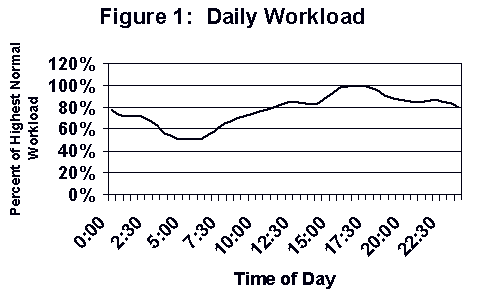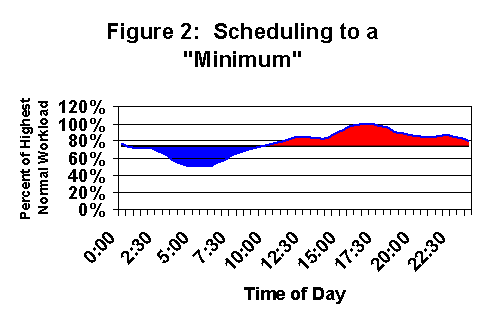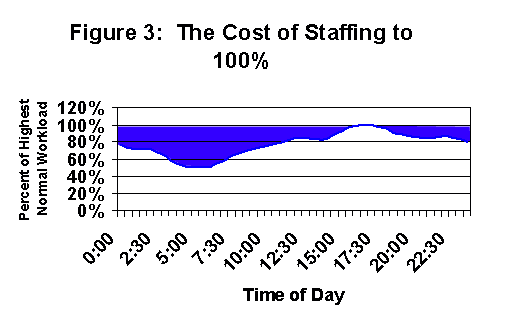Law enforcement agencies rely on shift work to accomplish their mission of public service and safety on a 24/7 basis. Despite a growing need for these services, agency budgets are often frozen or being reduced.
A common administrative strategy is to cap the available workforce at a headcount number that meets the budget. This can result in two common problems:
- Staffing may not be sufficient to meet the workload causing service levels to decline and increasing the risks to the officers on the street and the public in general.
- Overtime levels increase, causing costs to rise and the quality of life to deteriorate for the officers working the overtime.
Schedule Solutions
One solution to these problems is to customize the work schedule to better match the workload. This is often a complicated task because the workload in most departments varies from day to day and from hour to hour. A typical workload profile is shown below in Figure 1.

In smaller departments, it is a common practice to set a single minimum staffing requirement for the entire 24-hour period. For example, “A minimum of four officers will be on patrol at all times.” Schedules designed to meet this type of minimum staffing requirement do not address the real, variable workload requirement shown in Figure 1. As a result, the busy periods of the day are often understaffed and the less busy periods are overstaffed. Figure 2 shows an example of a department that is staffed to 75% of the maximum workload at all times.

The understaffed period (shown in red) from about 10:00 a.m. to Midnight is either addressed with overtime, or the service level to the community and safety for the officers and community is reduced during this time. Since reduced service and safety levels are usually unacceptable, overtime is the normal result of being understaffed.
The overstaffed situation from about 3:00 a.m. to 10:00 a.m. (shown in blue) has a minimal impact on safety and service. On the other hand, it unnecessarily increases coverage costs during this time period.
Using an alternative schedule to re-distribute personnel from the less-busy times to the higher workload periods enables the department to meet their coverage needs while significantly lowering the overtime levels needed for daily coverage. This has the added benefit of improving the schedule for the officers by lowering the proportion of night shifts worked as part of the overall schedule.
Staffing to Meet the 100% Workload Requirement
Another common strategy is to use level staffing at 100% of the highest normal workload. This will satisfy the safety and service needs of the community and officers. As you might expect, this strategy results in overstaffing during the less busy hours, making overstaffing the exception rather than the rule as shown in Figure 3.

The shaded area shows when and how much the department is overstaffed for the given workload. Improving the match between the coverage and the workload can significantly improve officer utilization without adversely affecting safety. For example, matching the coverage to workload (rescheduling personnel not needed during the less busy times to the busy times) would allow the same staffing to safely handle 29% more workload without increasing the headcount.
10-hour Shifts and Other Alternative Shift Lengths
Shiftwork Solutions receives frequent requests from police officers and their associations to design a schedule that uses 10-hour shifts. They believe this will give them more time off, without completely over-extending themselves on the days they work.
What they don’t realize is that schedules based on 10-hour or other alternative shift lengths often make it easier to match the variable workloads found in law enforcement agencies. Because of this, we often are able to design a customized shift schedule that satisfies both the officers and the agency. 10-hour shifts, for example, allow officers to get 25% more days off and 25% more weekends off than they would on an 8-hour shift schedule. If the longer shifts are acceptable to the workforce, this is a clear opportunity to improve the schedule from the workforce’s perspective while meeting the agency’s variable coverage requirements.
Call Us and We Can Help
Call or text us today at (415) 763-5005 to discuss your operations and how we can help you solve your shift work problems. You can also complete our contact form and we will call you.

One thought on “Law Enforcement”
Comments are closed.